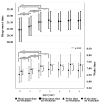Insufficient Sleep Syndrome in Childhood
- PMID: 39857849
- PMCID: PMC11763631
- DOI: 10.3390/children12010019
Insufficient Sleep Syndrome in Childhood
Abstract
Sleep disorders in children have a negative impact on mental and physical development, and a lack of sleep is one of the most important problems in infancy. At the age when naps are commonly accepted, the judgment of whether the amount of sleep is adequate has been based on the total amount of sleep per day. In other words, the idea is that even if the amount of sleep at night is insufficient, it is not considered insufficient if it is compensated for by taking a long nap or sleeping late on weekend mornings. However, these lifestyle habits disrupt the circadian rhythm and cause social jet lag, which is not appropriate for healthy mental and physical development. Therefore, in this review, I present the average required nighCime basic sleep duration (NBSD) of 10 h for Japanese and 11 h for Caucasian children as a judgment standard. (1) If the child sleeps less than 8 h at night, and (2) if the child sleeps less than 9 h at night or 30 to 60 min less than the required NBSD, immediate treatment is recommended. I also discuss briefly how to address sleep insufficiency in childhood.
Keywords: circadian rhythm; infants and early childhood; insufficient sleep syndrome; melatonin; nighttime basic sleep duration; sleep hygiene.
Conflict of interest statement
The author declares no conflict of interest.
Figures
References
-
- Hasegawa T., Murata S., Kagimura T., Omae K., Tanaka A., Takahashi K., Narusawa M., Konishi Y., Oniki K., Miike T. Characteristics and Transition of Sleep-Wake Rhythm in Nursery School Children: The Importance of Nocturnal Sleep. Clocks Sleep. 2024;6:668–681. doi: 10.3390/clockssleep6040045. - DOI - PMC - PubMed
Publication types
LinkOut - more resources
Full Text Sources
Research Materials



